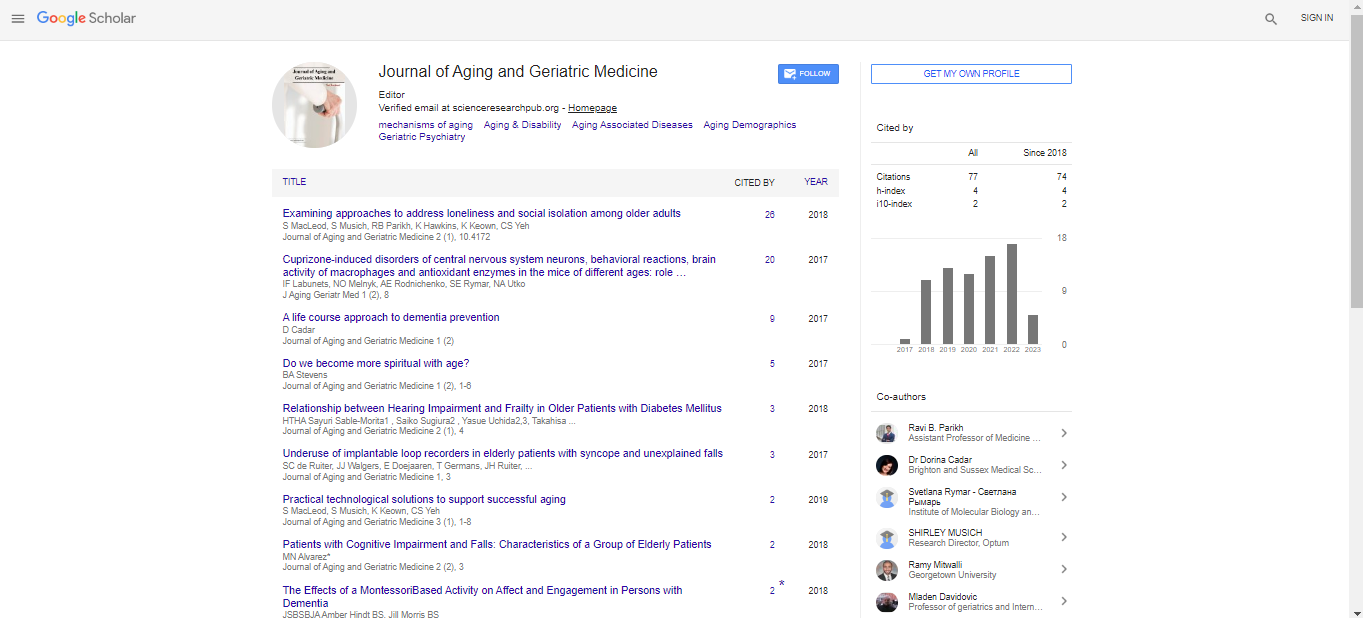Commentary, J Aging Geriatr Med Vol: 8 Issue: 1
Categories of Cardiomyopathy and its Effect on Older Adults
Atpheai Yareri*
Departments of Pediatrics and Medical and Molecular Genetics, Indiana University, Indianapolis, USA
- *Corresponding Author:
- Atpheai Yareri
Departments of Pediatrics and Medical and Molecular Genetics,
Indiana University,
Indianapolis,
USA
E-mail: atpheai_yareri@gmail.com
Received date: 04 November, 2023, Manuscript No. AGM-23-119219;
Editor assigned date: 07 November, 2023, PreQC No. AGM-23-119219 (PQ);
Reviewed date: 21 November, 2023, QC No. AGM-23-119219;
Revised date: 15 August, 2024, Manuscript No. AGM-23-119219 (R);
Published date: 22 August, 2024, DOI: 10.4172/2576-3946.1000185
Citation: Yareri A (2024) Categories of Cardiomyopathy and its Effect on Older Adults. J Aging Geriatr Med 8:1.
Description
The heart is one of the body's organs those ages along with a person. One disorder brought on by the deterioration of the cardiac tissue is cardiomyopathy. Primary and secondary cardiomyopathies are the two categories of cardiomyopathy. While secondary cardiomyopathies are associated with various underlying medical disorders, primary cardiomyopathies are exclusive to the heart muscle and can be acquired, hereditary, or both. Some studies show that the most common cardiomyopathy in the elderly is hypertrophic cardiomyopathy; others imply that dilated cardiomyopathy is the most common; yet others point to restricted cardiomyopathy. All those cardiomyopathies associated with aging are covered in this publication.
Age-related changes may make a person more susceptible to heart disease. The accumulation of fatty deposits in the artery walls over time is one of the main causes of heart disease. The good news is that you have options for mitigating, postponing, and even reversing your risk. Atherosclerosis is a condition that increases a person's chance of acquiring high blood pressure and other risk factors, such as age. Atherosclerosis is not always a natural aspect of aging because there are a number of modifiable risk factors for it. The accumulation of plaque within the walls of your arteries causes them to harden and narrow over time, limiting the amount of oxygen-rich blood that can reach your organs and other body components. The coronary arteries provide the heart muscle with blood nutrients and oxygen. Plaque accumulation in the coronary arteries, which lowers blood flow to the heart muscle, leads to the development of heart disease. Heart failure can arise from the weakening and/or injury of the heart muscle over time. Heart attacks, chronic hypertension, and other conditions can all lead to heart damage. Blood vessel and cardiac alterations can be brought on by aging. For instance, your heart can no longer beat as quickly under stressful situations or physical exertion as it could when you were younger. But with normal aging, the number of heart beats per minute (heart rate) at rest does not alter much.
One of the reasons for invalidity and negative results is cardiovascular disease. Numerous illnesses, including viral ones, have a negative impact on the myocardium and vascular system in addition to typical ailments like rheumatism, hypertension, and atherosclerosis, which lead to the development of cardiovascular insufficiency. Eighty present of acute infectious illness cases have circulatory dysfunctions, which are strongly linked to the disease's overall etiology. They have an impact on the infectious process's clinical trajectory and results. Monitoring infected patients and administering logical, particularly aggressive, treatment necessitate broad functional management of cardiovascular status at various phases of the illness.
Conclusion
The study demonstrates our extensive experience in developing clinical and electrocardiographic investigation problems in patients with infectious diseases. A critical appraisal of the current state of affairs based on evidence from the literature is provided. Individuals 65 years of age and beyond have a much higher risk than younger individuals of having a heart attack, stroke, coronary heart disease, or heart failure. Millions of older people's quality of life is being undermined and their activities restricted by heart disease, which is also a major source of disability.
 Spanish
Spanish  Chinese
Chinese  Russian
Russian  German
German  French
French  Japanese
Japanese  Portuguese
Portuguese  Hindi
Hindi 